Please Take Note: This is a review of the final game, but it might change slightly based on the success of the Kickstarter campaign. The game is being reviewed on the components and the rules provided with the understanding that “what you see is not what you might get” when the game is published. If you like what you read and want to learn more, we encourage you to visit the game publisher’s website or visit the Kickstarter campaign. Now that we have all that disclaimer junk out of the way, on with the review.
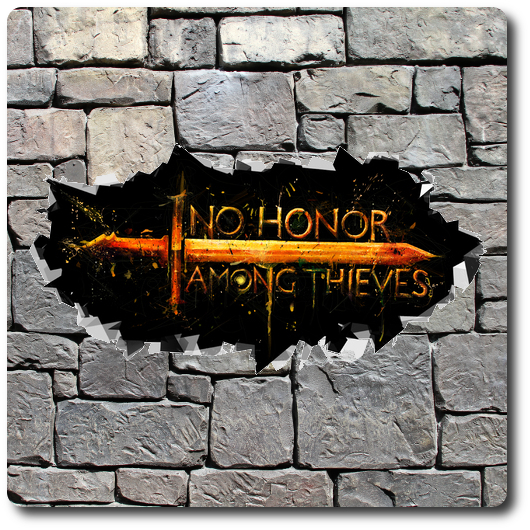
The Basics:
- For ages 9 and up (publisher suggests 13+)
- For 3 to 5 players
- Approximately 120 minutes to complete
Geek Skills:
- Active Listening & Communication
- Counting & Math
- Logical & Critical Decision Making
- Reading
- Strategy & Tactics
- Risk vs. Reward
- Cooperative & Team Play
- Hand/Resource Management
- Bluffing and Misdirection
- Auctioning, Bidding, & Trading
Learning Curve:
- Child – Moderate
- Adult – Easy
Theme & Narrative:
- Trust no one…
Endorsements:
- Gamer Geek approved!
- Parent Geek approved!
- Child Geek approved!
Overview
To be clear, you don’t think yourself a “bad person”. On the contrary, you consider yourself a talented artist. You have an uncanny knack to retrieve that which others jealously guard…and then sell it…for a huge profit. Some call you a thief, but you prefer the term “entrepreneur“. Of course, you have competition, but when it comes to a big score, even enemies become best of friends. For now…
No Honor Among Thieves, designed by Adam A. Watts and to be published by Carpe Omnis Games, will reportedly be comprised of 35 Character cards, 96 Scheme cards, 33 Defense cards, 18 Hidden Agenda cards, 12 Treasure cards, 5 Reference cards, 13 Objective mats, 1 Jail/Graveyard mat, 30 Copper coins, 20 Silver coins, 15 Gold coins, and 2 Dagger dice (custom six-sided dice). As this is a review of a prepublished game, I cannot comment on the game component quality. The illustrations depict various scenes of theft and pillaging in a fantasy city, complete with hooded thieves and well-armed guards.
With Friends Like This…
No Honor Among Thieves is driven by the escalating need to partner with individuals who are not looking out for the player’s best interest. However, to what degree a player needs to work with others is communicated to some degree by the cards in the game. Each card type is summarized here.
Character Cards
The Character cards represent the “talent” the player has hired to help pull off the jobs. These individuals bring with them Skills that are used to pull off heists, special Abilities that give them an advantage, and their fee to help.

Scheme Cards
Scheme cards represent the support network, information, and details of the jobs to come. These cards help the player when they are in a tight spot, providing Skill bonuses and other necessary improvements to just narrowly escape with the loot.
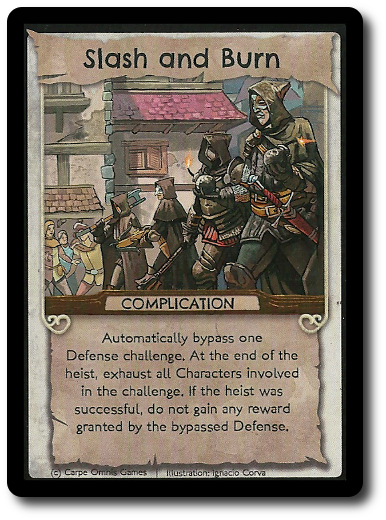
Objective Cards
Objective cards represent the item to be stolen. It includes how much it’ll be worth once fenced, along with the risk that must be taken (and possibly suffered) to obtain it. Knowing your objective helps the player determine if the job can be completed with just their crew of Characters or outside help and partnering with an opponent will be necessary.
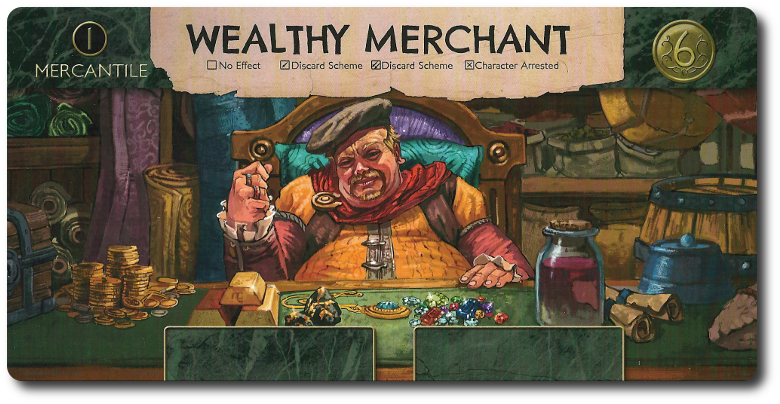
Defense Cards
Defense cards represent the guards, traps, and various other obstacles that are stopping would be thieves from grabbing the objective and running away into the night. The more difficult the defensive measures, however, the more money the player can get for an objective. If the Defense cards are successfully avoided (or flat-out beaten down in some cases), the player not only gets the Objective card, but a whole lot more coins for their trouble. Risk truly does give a player a reward in this game.
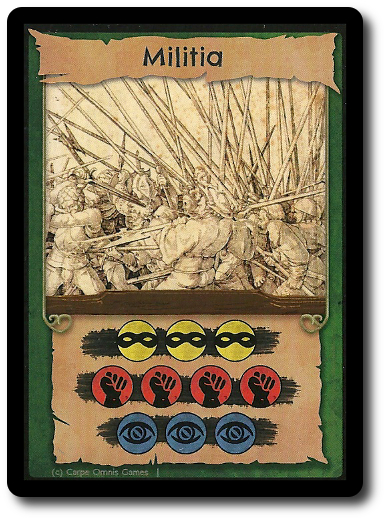
Treasure Cards
Treasure cards represent the little things that are found while attempting to grab the objective. These are additional items, bonuses for the player’s sticky fingers to snap up on their way out the window.
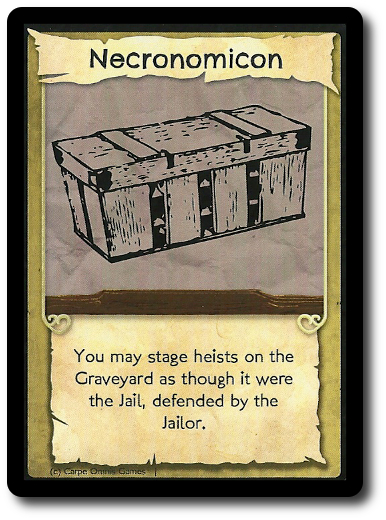
Hidden Agenda Cards
Hidden Agenda cards represent the player’s secret plans. These are kept secret for the duration of the game and only revealed when the game ends. They will award the player additional points if they are able to successfully complete their hidden agenda.
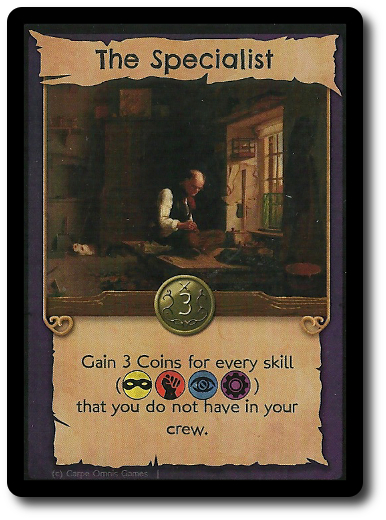
Thieves in the Night
To set up the game, first shuffle the Hidden Agenda cards and deal 3 to each player, face-down. Players review their cards and decide which 2 to keep, discarding the 1 Hidden Agenda card they will not be using face-down to a pile. The kept cards are the player’s Hidden Agendas for the duration of the game and they should remain hidden from opponents until the end of the game.
Second, take the Objective cards and divide them by their stage value (stage 1, 2, and 3). Shuffle each stage and then randomly discard 2 stage 1 Objectives and 2 stage 2 Objective cards, keeping the discarded Objective cards hidden and face-down. Then place the remaining Objective cards in a pile with stage 1 on top, stage 2 in the middle, and stage 3 on the bottom. Draw the first 2 Objective cards and place them face-up in the middle of the playing area.
Third, shuffle the Defense cards and place 1 face-up for every card slot on the Objective cards. Add the necessary coins as directed by the Defense cards to the Objective mat.
Fourth, place the Jail/Graveyard mat next to the Objective, with the “Honor Among Thieves” side face-up.
Sixth, give each player 6 coins and then shuffle the Character deck. Deal 2 Character cards per player face-up above the Objective to create the Hiring Pool.
Seventh, determine who will go first and then, in turn order sequence, have each player pick a face-up Character card and pay it’s price to add the card to the player’s hand (referred to as the player’s “Crew”). Once the last player picks their Character card, they go again and the order reverses with the first player going last the second time around. The only difference between the first and the second pass is that players do not pay the recruitment cost for their second Character card. Once a Character card is selected, it’s placed face-up in front of the owning player.
Eighth, draw another 5 Character cards to create the second Hiring Pool. Then draw 3 Character cards and put them in the “Jail” space on the Jail/Graveyard mat. Any coins still held by the players are theirs to keep.
Ninth, shuffle the Scheme cards and deal 4 to each player. These go into the player’s hand and should remain hidden until instructed to reveal them.
That’s it for game set up. Time to make some money and stab some backs.
Honor Versus Greed
No Honor Among Thieves is played in turns with no set number of turns per game. A player’s turn is summarized here.
Step 1: Discard Down
If the player has more than 7 Scheme cards at the start of their turn, they must discard down to a maximum of 7 cards.
Step 2: Take 3 Actions
The player can now take 3 actions in any order. After 3 actions have been taken, the player’s turn is over. The available actions to choose from are as follows.
Heist
The Heist action allows the player to attempt to take on an Objective or break Characters out of “Jail”. A Heist is fairly involved and can include a number of other players. The following steps are taken when a Heist action is initiated.
- Negotiate and plan with other opponents, promising various amounts of payment for their assistance. This is only necessary to do if the player doesn’t think they can do it alone.
- Send in the crew of Characters, countering Defense cards with the Crew’s collective Skills and abilities. The Heist succeeds if the Defense cards are bypassed.
- Complications may or may not occur if players want them to (think sabotage) by using Scheme cards, sending Characters to jail and even the graveyard.
- Determine if Heist action was successful.
- Determine if any of the players involved in the Heist action betrayed the others.
- Give payout (some players will be given more or less than what they agreed to based on possible betrayal).
Recruit
The Recruit action allows the player to take on new talent, including them in their Crew. The player pays the cost and takes the Character card from the Hiring Pool. A player can have a maximum of 4 Characters in their Crew.
Legwork
The Legwork action allows the player to draw as many Scheme cards as necessary to fill their hand to the maximum number of cards allowed.
Logistics
The Logistic action allows the player to play as many “Logistic” Scheme cards as they like.
Rest
The Rest action allows the player to refresh Character cards who were used in a Heist, making them available again to use.
Headhunting
The Headhunting action removes the currently available Character cards in the Hiring Pool, placing them on the bottom of the Character deck, and 5 new Character cards are then drawn.
Exchange
The Exchange action allows the player to trade cards with opponents.
Free Action: Fire Characters, Use Character Abilities, and Trade Coins
As a free action, the player can fire (discard) Characters, use Character abilities (where applicable), and exchange coins.
Betrayal and Honor
Character cards have certain abilities that will only be available if the game takes a sour turn. At the start of every game, an uneasy alliance is made between all the players. It’s only a matter of time until greed gets the better of someone and they betray their fellow thieves for the lure of wealth. When this happens, the Jail/Graveyard card is flipped over to reveal to all players that no one is to be trusted since there was a betrayal. Which shouldn’t come as a surprise to anyone.
But now the players have an additional problem. The game can end if the players do not work together to a certain degree. If too many thieves are running around and crime is rampant, the City Watch will crackdown and end the game. As such, players will need to keep working together and watch their backs.
Retirement
The game ends on the same turn as when a stage 3 Objective is successfully looted. All players now reveal their Hidden Agendas and resolve them, collecting coins as needed. Then all the players count their coins and announce their total. The player with the most coins wins the game!
However, all the players will lose the game if there are ever fewer than 6 total Character cards in play (not including those in the Hiring Pool, Jail, and Graveyard). Martial Law is declared and the City Watch wages war with the thieves, winning in the process.
To learn more about No Honor Among Thieves, visit the game publisher’s website or visit the Kickstarter campaign.
Final Word
 The Child Geeks had a bit of a learning curve when it came to the game. There are a lot of actions and they wanted to jump right into making a Heist. They quickly learned that preparation was key and working with other opponents could make things easier, but not necessarily better. According to one Child Geek, “I can’t do the job on my own and I know I could if I got some help, but I don’t want to share the loot.” Another Child Geek excitedly said, “If you want to get help, you have to get ready to share what you find or break the code of thieves to keep it. That’s a tough call to make unless there’s a lot of rich stuff!” The honor among the thieves never lasted more than about 3 turns until there was betrayal be 2 or more young Guild Masters at the same time. Which was hilarious. When all the jobs were done and every coin accounted for, the Child Geeks all agreed that No Honor Among Thieves was a lot of fun to play.
The Child Geeks had a bit of a learning curve when it came to the game. There are a lot of actions and they wanted to jump right into making a Heist. They quickly learned that preparation was key and working with other opponents could make things easier, but not necessarily better. According to one Child Geek, “I can’t do the job on my own and I know I could if I got some help, but I don’t want to share the loot.” Another Child Geek excitedly said, “If you want to get help, you have to get ready to share what you find or break the code of thieves to keep it. That’s a tough call to make unless there’s a lot of rich stuff!” The honor among the thieves never lasted more than about 3 turns until there was betrayal be 2 or more young Guild Masters at the same time. Which was hilarious. When all the jobs were done and every coin accounted for, the Child Geeks all agreed that No Honor Among Thieves was a lot of fun to play.
 The Parent Geeks also had a good time, finding the meta game of subtly manipulating and cheating others to be challenging and very entertaining. As one Parent Geek put it, “The look on another player’s face when you betray them after a successful heist is hilarious! It’s like I took their puppy.” Another Parent Geek said, “I learned a lot about other people while playing this game. For example, my boyfriend is very good at getting me to come along on a heist only to steal everything from me. I’m going to remember that.” Possible relationship problems aside, No Honor Among Thieves taught all the Parent Geeks two important lessons. The first is that cooperative play is necessary to steal the loot. Second, you only need to cooperate so far. When the games were over, the Parent Geeks all voted to approve No Honor Among Thieves.
The Parent Geeks also had a good time, finding the meta game of subtly manipulating and cheating others to be challenging and very entertaining. As one Parent Geek put it, “The look on another player’s face when you betray them after a successful heist is hilarious! It’s like I took their puppy.” Another Parent Geek said, “I learned a lot about other people while playing this game. For example, my boyfriend is very good at getting me to come along on a heist only to steal everything from me. I’m going to remember that.” Possible relationship problems aside, No Honor Among Thieves taught all the Parent Geeks two important lessons. The first is that cooperative play is necessary to steal the loot. Second, you only need to cooperate so far. When the games were over, the Parent Geeks all voted to approve No Honor Among Thieves.
 The Gamer Geeks liked many aspects of the game. Specifically, the bluffing, the negotiation, the risk versus reward, and the sometimes not so subtle backstabbing. Most importantly, they liked how the game was constantly changing, power shifted, and alliances dissolved just as quickly as they were created. According to one Gamer Geek, “This is exactly the kind of game I love playing. It’s not enough to learn the rules of the game. You have to invest a lot of time in the other players, learning what motivates them, and then using that to play the game against them.” Another Gamer Geek said, “A smart game. I like how it keeps the players together through thick and thin, but never forces players to work together if they really don’t want to.” The only aspect of the game that the Gamer Geeks didn’t care for was that what they could do was based on the cards they had in their hand. If they didn’t have the cards for the action or reaction, then they couldn’t do what they wanted. While this annoyed them, it was not a deal breaker, as there was always ways to go about getting things done. When the games were over, the Gamer Geeks approved No Honor Among Thieves.
The Gamer Geeks liked many aspects of the game. Specifically, the bluffing, the negotiation, the risk versus reward, and the sometimes not so subtle backstabbing. Most importantly, they liked how the game was constantly changing, power shifted, and alliances dissolved just as quickly as they were created. According to one Gamer Geek, “This is exactly the kind of game I love playing. It’s not enough to learn the rules of the game. You have to invest a lot of time in the other players, learning what motivates them, and then using that to play the game against them.” Another Gamer Geek said, “A smart game. I like how it keeps the players together through thick and thin, but never forces players to work together if they really don’t want to.” The only aspect of the game that the Gamer Geeks didn’t care for was that what they could do was based on the cards they had in their hand. If they didn’t have the cards for the action or reaction, then they couldn’t do what they wanted. While this annoyed them, it was not a deal breaker, as there was always ways to go about getting things done. When the games were over, the Gamer Geeks approved No Honor Among Thieves.
 When the game first starts, it’s pretty straight forward. Everyone knows they could go about doing jobs alone, but the risk of failing is dramatically reduced if they get help. The problems begin when the amount of loot captured is not enough to go around. Some players might feel like they are being taken advantage of or believe their business partners aren’t strong enough to stop them from taking control. This is where the game goes from difficult to convoluted. Once the treaties have been broken, anything goes, but players still need to work together. It’s a given that backstabbing will occur, even if you think you are on really good terms. This makes trust and working together difficult, but it’s absolutely necessary since none of the players are strong enough to tackle jobs on their own without real possible failure. The end result is a game that starts off tense and only gets more tense as it continues.
When the game first starts, it’s pretty straight forward. Everyone knows they could go about doing jobs alone, but the risk of failing is dramatically reduced if they get help. The problems begin when the amount of loot captured is not enough to go around. Some players might feel like they are being taken advantage of or believe their business partners aren’t strong enough to stop them from taking control. This is where the game goes from difficult to convoluted. Once the treaties have been broken, anything goes, but players still need to work together. It’s a given that backstabbing will occur, even if you think you are on really good terms. This makes trust and working together difficult, but it’s absolutely necessary since none of the players are strong enough to tackle jobs on their own without real possible failure. The end result is a game that starts off tense and only gets more tense as it continues.
If 120 minutes of play time sound long, understand that it takes time to negotiate deals, resolve backstabbing, and then spend 10 or so minutes talking excitedly about the last job the players took. This is a social game, full of discussion, negotiating, and heavy bluffing. That takes time and it’s the primary reason why No Honor Among Thieves is as long as it is. The actual resolution of a player’s turn is pretty quick up to when they take a Heist. Then things slow down, players focus in, and everyone has fun watching the caper unfold.
I was very pleased with No Honor Among Thieves. It had several game elements that I have always enjoyed. Specifically, bluffing and negotiation. I find games like this to be multi-leveled, with the game on the very top and the meta game of players attempting to out do one another below. It’s very satisfying.
Honor? Not likely. Betrayal? Certainly, but only to a point. If there is no profit in it, a wise players stays out of trouble. After all, players do have to work together in the game, but that doesn’t mean they have to like it. Do try this game when time allows. It’ll have you second guessing every opponent, desperately searching for signs of a motive, and cleverly hiding your own agenda among the confusion.
This is a paid for review of the game’s final prototype. Although our time and focus was financially compensated, our words are our own. We’d need at least 10 million dollars before we started saying what other people wanted. Such is the statuesque and legendary integrity of Father Geek which cannot be bought except by those who own their own private islands and small countries.
Discover more from Father Geek
Subscribe to get the latest posts sent to your email.

